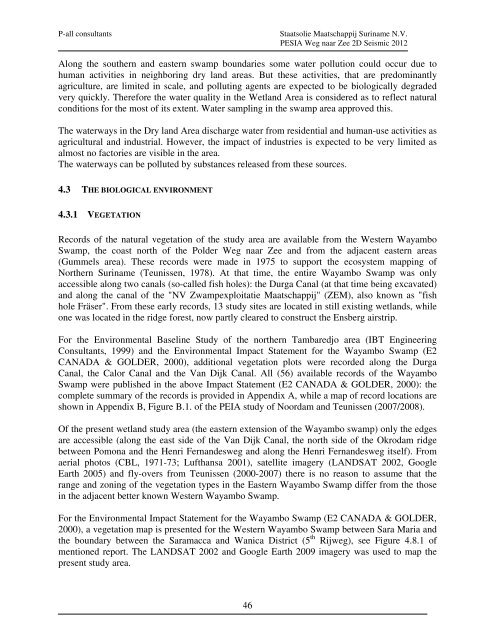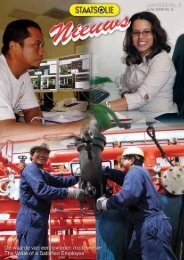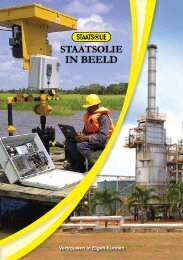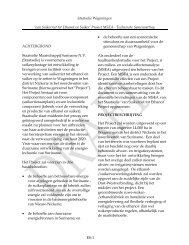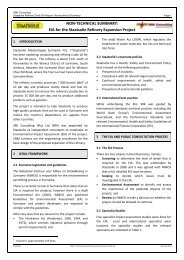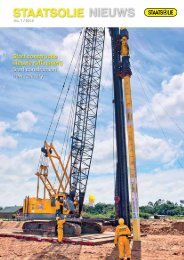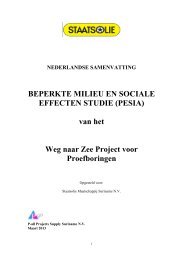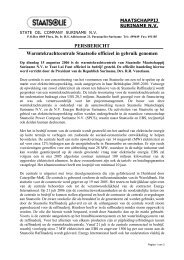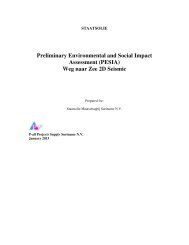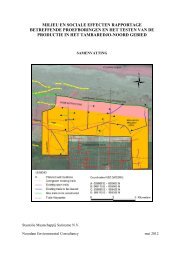(PESIA) Weg naar Zee 2D Seismic - Staatsolie
(PESIA) Weg naar Zee 2D Seismic - Staatsolie
(PESIA) Weg naar Zee 2D Seismic - Staatsolie
Create successful ePaper yourself
Turn your PDF publications into a flip-book with our unique Google optimized e-Paper software.
P-all consultants <strong>Staatsolie</strong> Maatschappij Suriname N.V.<br />
<strong>PESIA</strong> <strong>Weg</strong> <strong>naar</strong> <strong>Zee</strong> <strong>2D</strong> <strong>Seismic</strong> 2012<br />
Along the southern and eastern swamp boundaries some water pollution could occur due to<br />
human activities in neighboring dry land areas. But these activities, that are predominantly<br />
agriculture, are limited in scale, and polluting agents are expected to be biologically degraded<br />
very quickly. Therefore the water quality in the Wetland Area is considered as to reflect natural<br />
conditions for the most of its extent. Water sampling in the swamp area approved this.<br />
The waterways in the Dry land Area discharge water from residential and human-use activities as<br />
agricultural and industrial. However, the impact of industries is expected to be very limited as<br />
almost no factories are visible in the area.<br />
The waterways can be polluted by substances released from these sources.<br />
4.3 THE BIOLOGICAL ENVIRONMENT<br />
4.3.1 VEGETATION<br />
Records of the natural vegetation of the study area are available from the Western Wayambo<br />
Swamp, the coast north of the Polder <strong>Weg</strong> <strong>naar</strong> <strong>Zee</strong> and from the adjacent eastern areas<br />
(Gummels area). These records were made in 1975 to support the ecosystem mapping of<br />
Northern Suriname (Teunissen, 1978). At that time, the entire Wayambo Swamp was only<br />
accessible along two canals (so-called fish holes): the Durga Canal (at that time being excavated)<br />
and along the canal of the "NV Zwampexploitatie Maatschappij" (ZEM), also known as "fish<br />
hole Fräser". From these early records, 13 study sites are located in still existing wetlands, while<br />
one was located in the ridge forest, now partly cleared to construct the Ensberg airstrip.<br />
For the Environmental Baseline Study of the northern Tambaredjo area (IBT Engineering<br />
Consultants, 1999) and the Environmental Impact Statement for the Wayambo Swamp (E2<br />
CANADA & GOLDER, 2000), additional vegetation plots were recorded along the Durga<br />
Canal, the Calor Canal and the Van Dijk Canal. All (56) available records of the Wayambo<br />
Swamp were published in the above Impact Statement (E2 CANADA & GOLDER, 2000): the<br />
complete summary of the records is provided in Appendix A, while a map of record locations are<br />
shown in Appendix B, Figure B.1. of the PEIA study of Noordam and Teunissen (2007/2008).<br />
Of the present wetland study area (the eastern extension of the Wayambo swamp) only the edges<br />
are accessible (along the east side of the Van Dijk Canal, the north side of the Okrodam ridge<br />
between Pomona and the Henri Fernandesweg and along the Henri Fernandesweg itself). From<br />
aerial photos (CBL, 1971-73; Lufthansa 2001), satellite imagery (LANDSAT 2002, Google<br />
Earth 2005) and fly-overs from Teunissen (2000-2007) there is no reason to assume that the<br />
range and zoning of the vegetation types in the Eastern Wayambo Swamp differ from the those<br />
in the adjacent better known Western Wayambo Swamp.<br />
For the Environmental Impact Statement for the Wayambo Swamp (E2 CANADA & GOLDER,<br />
2000), a vegetation map is presented for the Western Wayambo Swamp between Sara Maria and<br />
the boundary between the Saramacca and Wanica District (5 th Rijweg), see Figure 4.8.1 of<br />
mentioned report. The LANDSAT 2002 and Google Earth 2009 imagery was used to map the<br />
present study area.<br />
46


